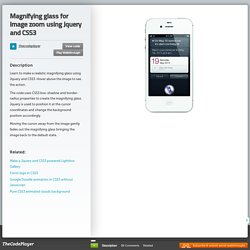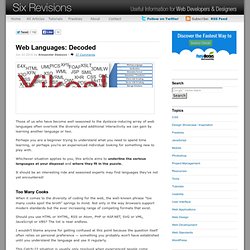

Magnifying glass for image zoom using Jquery and CSS3. View codePlay Walkthrough Description Learn to make a realistic magnifying glass using Jquery and CSS3.

Hover above the image to see the action. The code uses CSS3 box-shadow and border-radius properties to create the magnifying glass. Jquery is used to position it at the cursor coordinates and change the background position accordingly. Moving the cursor away from the image gently fades out the magnifying glass bringing the image back to the default state. Estimated reading time in web design. Written by Brian Cray on April 9th, 2010 Jakob Nielsen's Alertbox is like a living web design bible for me.

In case you don't know Mr. Nielsen, he's considered one of the top web usability experts in the world, and his Alertbox is filled with extremely well-researched articles on how people use the Web. Users don't read (more than 18%) About 2 years ago Jakob Nielsen wrote an "Alertbox" titled How little do users read?. Reducing bad signup emails with mailcheck.js. I recently stumbled across mailcheck.js, a little jQuery plugin from Kicksend that suggests domains based on common typos in email forms.

For example, 'user@gnail.co' will generate a suggestion for 'user@gmail.com'. It's perfect for preventing errors in user signups, and the authors claim its reduced their email bounces by 50%. After playing around with it, I've decided to bundle it into production for most, if not all of my projects, and this is just a brief demo of what can be done with it. Getting Set Up Our goal is to create a simple display that shows email suggestions to the user and offers a way to automatically fill in the field with the suggestion. The setup is only a few lines, although it's important to understand what's going on. Using the suggestion object Mailcheck automatically generates our field suggestions for us, but how do we use them? We have access to the address (what comes before the @), the suggested domain, and the entire suggested text.
Web Languages: Decoded. Those of us who have become well seasoned to the dyslexia-inducing array of web languages often overlook the diversity and additional interactivity we can gain by learning another language or two.

Perhaps you are a beginner trying to understand what you need to spend time learning, or perhaps you’re an experienced individual looking for something new to play with. Whichever situation applies to you, this article aims to underline the various languages at your disposal and where they fit in the puzzle. It should be an interesting ride and seasoned experts may find languages they’ve not yet encountered! Too Many Cooks When it comes to the diversity of coding for the web, the well-known phrase "too many cooks spoil the broth" springs to mind. Should you use HTML or XHTML, RSS or Atom, PHP or ASP.NET, SVG or VML, JavaScript or VBS? Enough abbreviations to make an English scholar tremble (and give you a migraine)! What Web Language Should You Learn? HTML5: seriously, it's not just for video. In a way, HTML5 has been reduced to a buzzword.

You hear a lot of noise about how great it is for video, and how the web standard is an alternative to Flash content, but you don't see a whole lot of examples of that. We thought we'd take a moment and round up some of the cooler, more exciting instances of HTML5 online -- sites and experiments that go way beyond just playing someone's home movies. We're talking 8-bit gaming, some really crazy video effects, and a handful of incredibly interesting ways designers are maximizing the potential of the everyone's favorite new toy.
Check out the links below, and prepare to readjust your expectations of HTML5. Note: Your best experiences for the links below will be in Chrome or Safari. These will absolutely blow your mind. Comments. [Infographic] PHP vs. Python vs. Ruby.